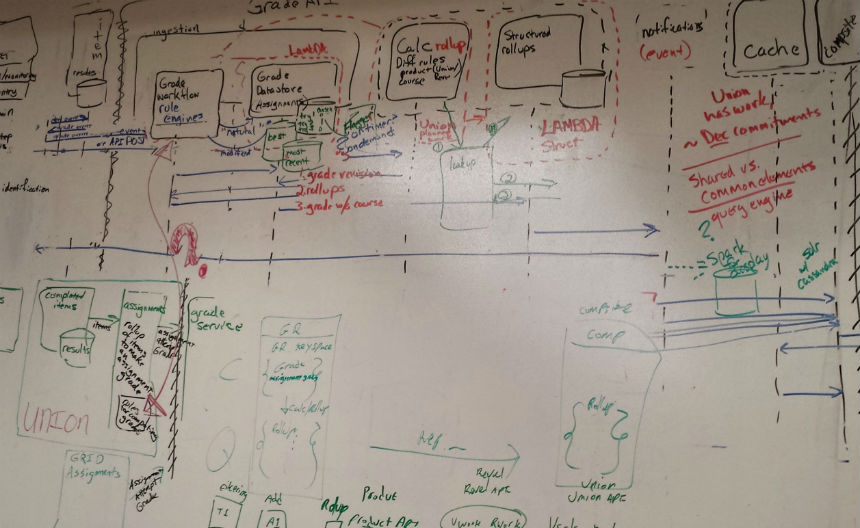
We need to learn from stories. While the Internet is awash with tales of success it is harder to find write-ups on what didn't work. It is a shame. Cautionary tales are a valuable source of learning. They are what helps us, collectively, get better at our craft.
"What's far more precious than being fluent in programming languages and tooling is the ability to collaborate and empower each other." - Fox
But few people want to be associated with a failure. And recounting the events of what happened, done incorrectly, leads to finger pointing, hurt feelings, and even retribution. Even though people may intellectually understand how this is a worthwhile, creating a storytelling culture is difficult to get right.
Creating a Storytelling Culture
How do you create a culture? Specifically, how do you create an environment where success incrementally builds from repeatedly shared experience? In the book Blue Ocean Strategy by W. Chan Kim and Renee Mauborgne four major hurdles to changing cultures are listed:
- Cognitive - people must have some understanding of why the change in strategy or culture is needed
- Limited Resources - changing an organization will require shifting resources away from some areas and towards others
- Motivation - people have to want to make the change
- Institutional Politics - the possibility of change needs to be supported from those with the authority to do so
The Cognitive Barrier
To pass the cognitive barrier, everyone needs to understand why a storytelling culture is valuable. Knowledge transfer, as obvious as it is to some, may not be high on the list of priorities for many. Not painting oneself into a corner or reducing time by leveraging other's experience is extremely valuable to an organization. Any opportunity to buttress abstract rationale with by sharing specific examples should be taken. Employees need to hear a clear, consistent message:
We will try things and they may not all work out. That's more than OK; that's expected. We'll learn from what happened, good or bad, and get better at what we do in the process.
The Resources Barrier
If a cultural change represents a moonshot then rallying the momentous support necessary is difficult. What's worse, failure at such a grand scale will be demoralizing and will dissuading subsequent attempts, even if the original vision was worthwhile.
It is better to start with small, almost seemingly insignificant interventions. One can't bray about how this is the silver bullet, sure to fix all that ails them. Instead, it is much more palatable to couch something as 'just a tweak', or as 'only temporary to see what happens'. Any reasonable person is much less likely to be defensive against small, incremental ideas; the boat hasn't been burned and they're not stuck against their will. The are empowered to have a say in determining how things go.
The Motivations Barrier
Motivating people to create a storytelling culture is different than cognitively justifying why it is important. People may understand that sharing their experience is laudable but are unmotivated to do so.
Motivation comes in two forms: extrinsic and intrinsic. Extrinsic motivators, like a financial bonus, are those rewards for specific actions that are external to the work itself. Intrinsic motivations are those psychological rewards that employees get from doing work they know is meaningful.
If an employee's bonus is tied to the number of bugs they fix then they are financially motivated to spend time fixing bugs. Writing up the necessary steps to prevent bugs from happening, ironically, is now not in their financial interest.
Likewise, the effort to document a complex solution needs to be celebrated. Having the time spent frowned upon and the artifact subsequently banished to a CMS back-alley, unread, is a powerful (intrinsic) deterrent.
The Institutional Barrier
Finally, those with authority must agree that a storytelling culture is important and be willing to communicate that message. If management is unwilling to discuss why knowledge transfer is important (the cognitive barrier), support small, incremental efforts (the resource barrier), and shape intrinsic and external rewards to create the desired behaviors (the motivation barrier) then any effort will be extremely brittle.
Wrapping Up
Does your company view documentation as an "extracurricular chore" that detracts from "real work"? Do you share postmortem findings with other teams after major efforts? How easily are you able to discuss with others in the organization what you've learned? Are failures buried, never to be mentioned again? Do you have a collaborative culture, eager to learn from its mistakes or one that is only intent on trumpeting its wins?
More to the point: if you don't have a culture where it is safe to share the stories of failure honestly, how will you change it?
(What does openly sharing one's experience look like? Richard Clayton's Failing at Microservices needs kudos not only for it's merit; that his team, his company, and his culture felt that these lessons were ok to share is wonderful. We're better API practitioners because of it.)
(Update: 2020-03-25) Since publishing, I have read a number of additional books unpacking digital transformation and shifting corporate behavior. Two of the best are Agendashift, by Mike Burrows, and Switch, by Chip and Dan Heath.




